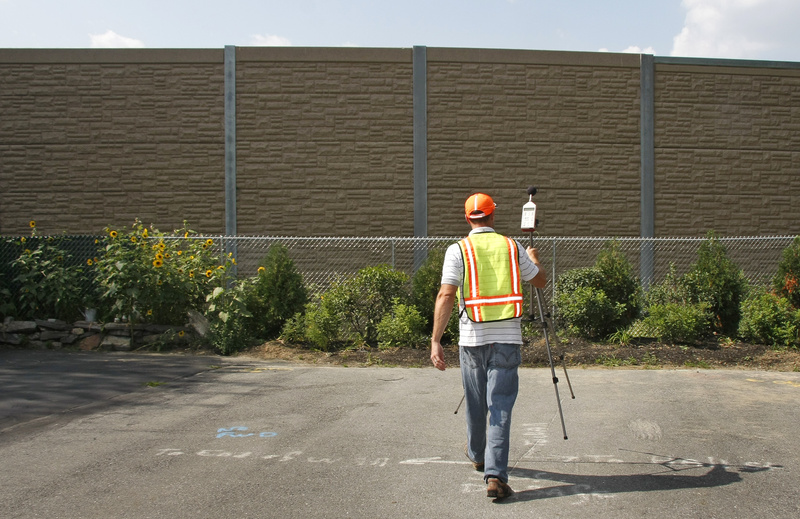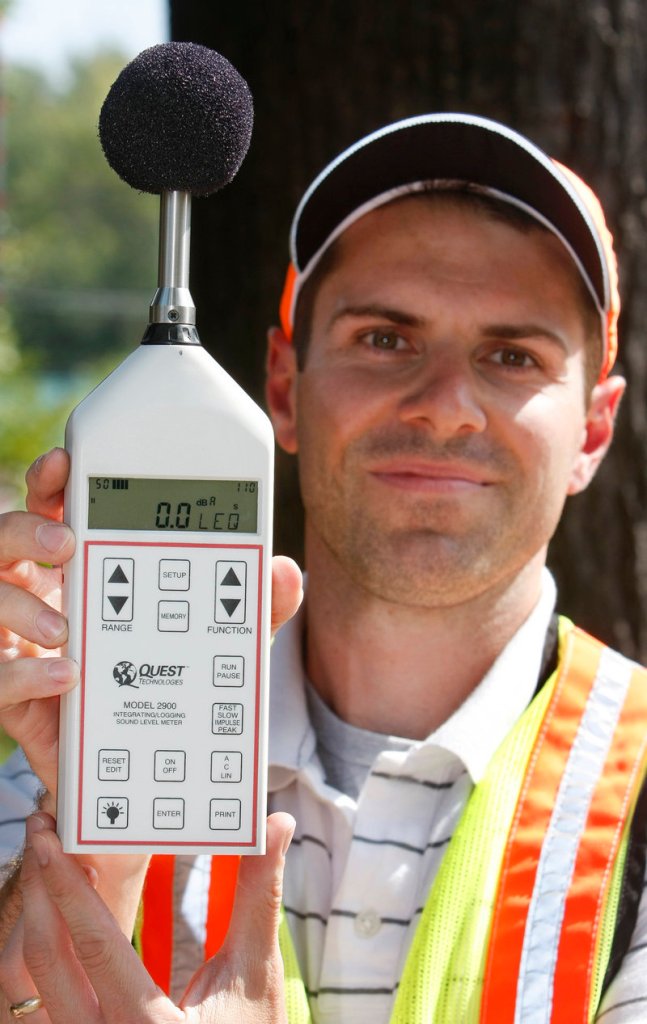SOUTH PORTLAND – The hum of traffic is still in the air on Hobart Street, but a sound meter showed Wednesday that the noise is about half what it was before the wall went up.
That seemed like a reasonable conclusion to Peter Jamieson, who lives with his wife, Diane, in a house next to the sound wall that separates their neighborhood from Interstate 295.
“You can sit down on the back porch now,” Jamieson said. “It was bad enough (before) where she couldn’t hear me and I couldn’t hear her.”
Nate Howard, a noise specialist for the state Department of Transportation, and Joe Siviski, an intern, measured sound levels in the neighborhood between the highway and Broadway on Wednesday afternoon. Their goal was to see how well the $1.5 million, 3,550-foot-long wall is protecting residents from traffic noise.
The state erected the concrete-and-wood composite wall — southern Maine’s first highway sound wall — earlier this year. It was part of a larger project that added a lane to I-295, bringing the highway that much closer to the neighborhood.
The wall was designed to reduce traffic noise by about 10 decibels around the homes closest to the highway. That’s what Howard found Wednesday when he returned to eight sites where he measured in 2008.
“I’m pretty happy about that achieving what we predicted,” he said.
To the human ear, a 10-decibel decrease cuts the noise by half, Howard said. A five-decibel difference isn’t readily noticeable. A three-decibel difference is the smallest difference most people would detect.
Under federal highway standards, areas where the level is at or above 67 decibels are considered impacted by traffic noise. That is the level at which noise begins to interrupt normal conversation, Howard said.
In 2008, Howard found decibel levels of 71 to 74 — louder than a busy restaurant but not as loud as a garbage disposal — in places closest to the highway.
On Wednesday, he and Siviski went around the neighborhood wearing the department’s bright orange caps and fluorescent tops. They put a meter on a tripod at each designated spot, and left it for some time before checking the readings.
Their measurements at the end of Hobart Street were 61 and 64 decibels on Wednesday, compared with 71 in 2008.
On Evergreen Road, which runs roughly parallel with the highway, the measurements were 60 and 62, compared with 71 two years ago. At the end of Hall Street, both measurements Wednesday were 63, compared with 74 in 2008.
Paul “Andy” Anderson’s, whose home on Hall Street is only about 10 feet from the wall, said, “It works!”
“My wife insists there’s no difference,” he said, “but I can sit in my chair just inside the door with the back windows open. Before (the wall went up), I couldn’t do that.”
A little distance can make a big difference. Sound measurements taken a few houses away from the wall Wednesday were generally in the 50s — somewhere between background music and normal speech. That also was the case for those locations in 2008.
In at least one spot, Wednesday’s measurements showed more noise. Several doors down from Jamieson, the readings were 58 and 62, compared with 57 in 2008.
For both tests, Howard measured the noise late in the afternoon on a summer weekday. But measuring sound in a neighborhood isn’t an exact science. Some meters were in place longer than others, and factors besides the highway can affect the readings.
The measurement for one spot — where a car passed with blaring music and someone nearby worked with loud hedge trimmers — would likely be thrown out.
“It’s been amazing. There’s been absolutely no barking dogs,” Howard said. “That’s great!”
Staff Writer Ann S. Kim can be contacted at 791-6383 or at:
akim@pressherald.com
Send questions/comments to the editors.





Success. Please wait for the page to reload. If the page does not reload within 5 seconds, please refresh the page.
Enter your email and password to access comments.
Hi, to comment on stories you must . This profile is in addition to your subscription and website login.
Already have a commenting profile? .
Invalid username/password.
Please check your email to confirm and complete your registration.
Only subscribers are eligible to post comments. Please subscribe or login first for digital access. Here’s why.
Use the form below to reset your password. When you've submitted your account email, we will send an email with a reset code.